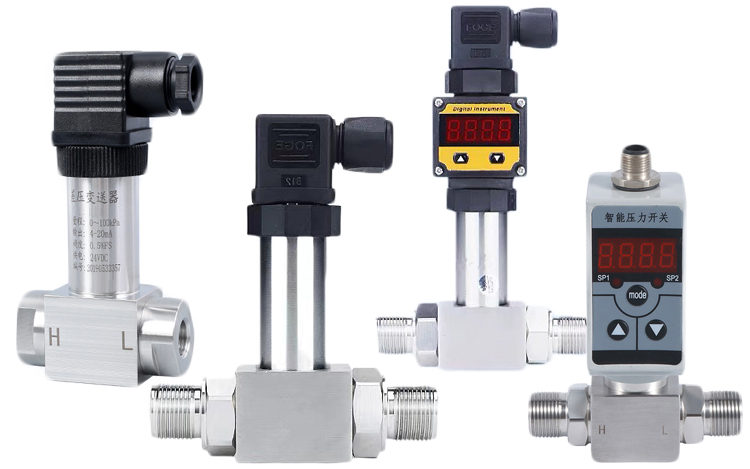Introduction: The Role of Pressure Gauges in Industrial Settings
Pressure gauges are fundamental components in industrial environments, ensuring the safe and efficient operation of various systems. Among these, differential pressure transmitters stand out due to their ability to measure the difference in pressure between two points. This measurement is crucial in applications such as monitoring filtration systems, managing fluid flow, and ensuring proper functioning of HVAC systems. For purchasing managers and application engineers, selecting the right differential pressure gauge or transmitter is vital for maintaining accuracy, reliability, and cost-effectiveness in their operations.

Measurement Principles: How Differential Pressure Transmitters Work
Differential pressure transmitters operate by measuring the pressure difference between two points, typically using a diaphragm or other sensing elements. Here’s how it works:
- Diaphragm-based Sensors: The most common type, where a diaphragm is placed between two pressure inlets. The differential pressure causes the diaphragm to deflect, which is then converted into an electrical signal proportional to the pressure difference.
- Capacitance-based Sensors: These devices use changes in capacitance to measure pressure differences. As the pressure changes, the diaphragm’s position alters the capacitance, providing a precise measurement.
- Resonant Sensors: These utilize a resonating element that changes frequency in response to pressure variations. They are known for high accuracy and stability in specific applications.
Each of these technologies offers different benefits, and understanding their working principles helps in choosing the right device based on the application.
Accuracy and Precision: Performance in Various Environments
Accuracy and precision are critical when selecting a differential pressure transmitter. The type of environment—whether it’s a clean room, a harsh industrial setting, or an outdoor installation—can significantly impact the performance of these devices.
- Diaphragm-based Sensors: These are typically very accurate, with an accuracy range of ±0.075% to ±0.25% of full scale. They are suitable for applications where high precision is needed, such as in laboratory settings or for sensitive chemical processes.
- Capacitance-based Sensors: These devices offer a high degree of accuracy, especially in low-pressure applications. However, they can be affected by environmental factors such as temperature and humidity, which may require additional compensation.
- Resonant Sensors: Known for their extreme accuracy, resonant sensors can achieve accuracy levels of ±0.02% of full scale. They are ideal for critical applications where even the smallest measurement errors could lead to significant issues, such as in aerospace or pharmaceuticals.
Reliability and Durability: Ensuring Longevity in Industrial Applications
In industrial applications, the reliability and durability of differential pressure transmitters are paramount. These devices must withstand harsh conditions, including exposure to chemicals, extreme temperatures, and mechanical vibrations.
- Diaphragm-based Sensors: These are generally robust, with a long lifespan. They require minimal maintenance, making them suitable for applications where long-term reliability is essential.
- Capacitance-based Sensors: While accurate, these sensors may require more frequent calibration and maintenance due to their sensitivity to environmental factors. However, they offer a good balance between cost and performance in controlled environments.
- Resonant Sensors: These are often the most durable and reliable, with a long operational life and minimal drift over time. They are ideal for applications where maintenance opportunities are limited, and reliability is critical.
Cost Considerations: Balancing Initial Investment with Long-term Value
Cost is always a critical factor when selecting a differential pressure transmitter. The initial purchase price, along with maintenance and operational costs, must be carefully considered.
- Diaphragm-based Sensors: These are generally more affordable and offer good value for money, especially in applications where ultra-high precision is not necessary. Their low maintenance requirements further reduce the total cost of ownership.
- Capacitance-based Sensors: These are moderately priced but may incur higher long-term costs due to maintenance and calibration needs. They are suitable for applications with moderate accuracy requirements and stable environmental conditions.
- Resonant Sensors: Typically, these are the most expensive upfront but offer the lowest long-term costs due to their high reliability and minimal maintenance needs. They are the best choice for critical applications where downtime can be extremely costly.
Use Cases: Choosing the Right Device for Your Application
Different industrial scenarios require different types of differential pressure transmitters. Here are some examples:
- HVAC Systems: Diaphragm-based sensors are often preferred due to their balance of accuracy, durability, and cost-effectiveness. They ensure proper airflow and system efficiency without the need for frequent maintenance.
- Chemical Processing: In environments where chemical resistance and high accuracy are critical, capacitance-based sensors may be the best choice. However, care must be taken to manage environmental factors.
- Pharmaceutical Manufacturing: Resonant sensors are ideal in this context, where even minor deviations in pressure can affect product quality. Their high precision and reliability ensure consistent performance in stringent conditions.
Conclusion: Making the Right Choice for Your Industrial Needs
Selecting the appropriate differential pressure transmitter is crucial for optimizing performance, ensuring reliability, and managing costs in industrial applications. By understanding the measurement principles, accuracy, reliability, and cost considerations, purchasing managers and application engineers can make informed decisions that align with their specific requirements.
For industries where precision is paramount, such as pharmaceuticals or aerospace, investing in high-accuracy resonant sensors may be worth the higher initial cost. In contrast, for applications like HVAC systems, a more cost-effective diaphragm-based sensor may be sufficient.
Call to Action: To explore the best differential pressure transmitters for your specific needs, contact our team today for a consultation or product demonstration. Whether you prioritize cost-efficiency or cutting-edge accuracy, we have a solution tailored for you.
References:
- Wikipedia on Pressure Sensors – A comprehensive overview of pressure sensors.
By offering well-rounded information with a focus on both technical details and practical considerations, this article aims to help professionals in making an informed decision that aligns with their operational needs and budget constraints.




